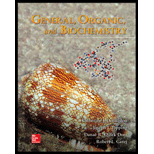
GENERAL ORGANIC+BIOCHEM.-ACCESS>CUSTOM<
10th Edition
ISBN: 9781265799274
Author: Denniston
Publisher: MCG CUSTOM
expand_more
expand_more
format_list_bulleted
Concept explainers
Question
Chapter 16.5, Problem 16.11Q
Interpretation Introduction
Interpretation:
Structure of D-galactose has to be drawn.
Expert Solution & Answer
Want to see the full answer?
Check out a sample textbook solution
Students have asked these similar questions
Which of the following is true for a particular reaction if ∆G° is -40.0 kJ/mol at 290 K and –20.0 kJ/mol at 390 K?
What is the major product of the following reaction?
O
O
OH
OH
1. BH
2. H₂O₂, NaOH
OH
OH
Draw the products formed when each ester is hydrolyzed with water and sulfuric acid.
Chapter 16 Solutions
GENERAL ORGANIC+BIOCHEM.-ACCESS>CUSTOM<
Ch. 16.1 - Prob. 16.1QCh. 16.1 - Why is it important to learn the commonly used...Ch. 16.2 - What is the current recommendation for the amount...Ch. 16.2 - Prob. 16.4QCh. 16.3 - Prob. 16.5QCh. 16.3 - Prob. 16.6QCh. 16.4 - Prob. 16.1PPCh. 16.4 - Prob. 16.2PPCh. 16.4 - Prob. 16.3PPCh. 16.4 - Prob. 16.7Q
Ch. 16.4 - Prob. 16.8QCh. 16.4 - Prob. 16.9QCh. 16.4 - Prob. 16.10QCh. 16.5 - Prob. 16.4PPCh. 16.5 - Prob. 16.11QCh. 16.5 - Prob. 16.12QCh. 16.5 - Prob. 16.5PPCh. 16.7 - Prob. 16.13QCh. 16.7 - Prob. 16.14QCh. 16 - Prob. 16.15QPCh. 16 - Prob. 16.16QPCh. 16 - Prob. 16.19QPCh. 16 - Prob. 16.20QPCh. 16 - Prob. 16.21QPCh. 16 - Prob. 16.22QPCh. 16 - Prob. 16.23QPCh. 16 - Prob. 16.24QPCh. 16 - Prob. 16.25QPCh. 16 - Prob. 16.26QPCh. 16 - Prob. 16.27QPCh. 16 - Prob. 16.28QPCh. 16 - Prob. 16.29QPCh. 16 - Prob. 16.30QPCh. 16 - Prob. 16.31QPCh. 16 - Prob. 16.32QPCh. 16 - Prob. 16.33QPCh. 16 - Prob. 16.34QPCh. 16 - Prob. 16.35QPCh. 16 - Prob. 16.36QPCh. 16 - Prob. 16.37QPCh. 16 - Prob. 16.38QPCh. 16 - Prob. 16.39QPCh. 16 - Prob. 16.40QPCh. 16 - Prob. 16.41QPCh. 16 - Prob. 16.42QPCh. 16 - Prob. 16.43QPCh. 16 - Prob. 16.44QPCh. 16 - Prob. 16.45QPCh. 16 - Prob. 16.46QPCh. 16 - Prob. 16.47QPCh. 16 - Prob. 16.48QPCh. 16 - Prob. 16.49QPCh. 16 - Prob. 16.50QPCh. 16 - Prob. 16.51QPCh. 16 - Prob. 16.52QPCh. 16 - Prob. 16.53QPCh. 16 - Prob. 16.54QPCh. 16 - Prob. 16.55QPCh. 16 - Prob. 16.56QPCh. 16 - Prob. 16.57QPCh. 16 - Prob. 16.58QPCh. 16 - Prob. 16.59QPCh. 16 - Prob. 16.60QPCh. 16 - Prob. 16.61QPCh. 16 - Prob. 16.62QPCh. 16 - Prob. 16.63QPCh. 16 - Prob. 16.64QPCh. 16 - Prob. 16.65QPCh. 16 - Prob. 16.66QPCh. 16 - Prob. 16.67QPCh. 16 - Prob. 16.68QPCh. 16 - Prob. 16.69QPCh. 16 - Prob. 16.70QPCh. 16 - Prob. 16.71QPCh. 16 - Prob. 16.72QPCh. 16 - Prob. 16.73QPCh. 16 - Prob. 16.74QPCh. 16 - Prob. 16.75QPCh. 16 - Prob. 16.76QPCh. 16 - Prob. 16.77QPCh. 16 - Prob. 16.78QPCh. 16 - Prob. 16.79QPCh. 16 - Prob. 16.80QPCh. 16 - Prob. 16.81QPCh. 16 - Prob. 16.82QPCh. 16 - Prob. 16.83QPCh. 16 - Prob. 16.84QPCh. 16 - Prob. 16.85QPCh. 16 - Prob. 16.86QPCh. 16 - Prob. 16.87QPCh. 16 - Prob. 16.88QPCh. 16 - Prob. 16.89QPCh. 16 - Prob. 16.90QPCh. 16 - Prob. 16.91QPCh. 16 - Prob. 16.92QPCh. 16 - Prob. 16.93QPCh. 16 - How does the structure of amylose differ from that...Ch. 16 - Prob. 16.95QPCh. 16 - Prob. 16.96QPCh. 16 - Prob. 16.97QPCh. 16 - Prob. 16.98QPCh. 16 - Prob. 1MCPCh. 16 - Prob. 2MCPCh. 16 - Prob. 4MCPCh. 16 - Prob. 5MCPCh. 16 - Prob. 6MCPCh. 16 - Prob. 7MCPCh. 16 - Prob. 8MCPCh. 16 - Prob. 9MCP
Knowledge Booster
Learn more about
Need a deep-dive on the concept behind this application? Look no further. Learn more about this topic, chemistry and related others by exploring similar questions and additional content below.Similar questions
- Draw the products of the hydrolysis reaction between the ester molecule and water. Determine the products of the following reaction.arrow_forwardWhat is the unsaturation number for compounds with the formula C₂H₁₂Cl₂? O õ õ o o 4 3arrow_forwardIndicate the product obtained (formula). F3C. CF3 Br NH2 NH OMe K2CO3, DABCO, DMFarrow_forward
- What are the missing intermediates 1, 2, and 3? Please include a detailed explanation explaining the steps of malonic ester synthesis. Please include drawings of the intermediates and how they occur.arrow_forwardThe following intermediates are to proceed by acetoacetic ester synthesis. What are intermediates 1 and 2 plus the final product 3? Please include a detailed explanation and drawings of the intermediates and how they occurred.arrow_forwardThe chemical formula of "benzimidazole E" is C7H6N2. Draw it.arrow_forward
arrow_back_ios
SEE MORE QUESTIONS
arrow_forward_ios
Recommended textbooks for you
 ChemistryChemistryISBN:9781305957404Author:Steven S. Zumdahl, Susan A. Zumdahl, Donald J. DeCostePublisher:Cengage Learning
ChemistryChemistryISBN:9781305957404Author:Steven S. Zumdahl, Susan A. Zumdahl, Donald J. DeCostePublisher:Cengage Learning ChemistryChemistryISBN:9781259911156Author:Raymond Chang Dr., Jason Overby ProfessorPublisher:McGraw-Hill Education
ChemistryChemistryISBN:9781259911156Author:Raymond Chang Dr., Jason Overby ProfessorPublisher:McGraw-Hill Education Principles of Instrumental AnalysisChemistryISBN:9781305577213Author:Douglas A. Skoog, F. James Holler, Stanley R. CrouchPublisher:Cengage Learning
Principles of Instrumental AnalysisChemistryISBN:9781305577213Author:Douglas A. Skoog, F. James Holler, Stanley R. CrouchPublisher:Cengage Learning Organic ChemistryChemistryISBN:9780078021558Author:Janice Gorzynski Smith Dr.Publisher:McGraw-Hill Education
Organic ChemistryChemistryISBN:9780078021558Author:Janice Gorzynski Smith Dr.Publisher:McGraw-Hill Education Chemistry: Principles and ReactionsChemistryISBN:9781305079373Author:William L. Masterton, Cecile N. HurleyPublisher:Cengage Learning
Chemistry: Principles and ReactionsChemistryISBN:9781305079373Author:William L. Masterton, Cecile N. HurleyPublisher:Cengage Learning Elementary Principles of Chemical Processes, Bind...ChemistryISBN:9781118431221Author:Richard M. Felder, Ronald W. Rousseau, Lisa G. BullardPublisher:WILEY
Elementary Principles of Chemical Processes, Bind...ChemistryISBN:9781118431221Author:Richard M. Felder, Ronald W. Rousseau, Lisa G. BullardPublisher:WILEY

Chemistry
Chemistry
ISBN:9781305957404
Author:Steven S. Zumdahl, Susan A. Zumdahl, Donald J. DeCoste
Publisher:Cengage Learning

Chemistry
Chemistry
ISBN:9781259911156
Author:Raymond Chang Dr., Jason Overby Professor
Publisher:McGraw-Hill Education

Principles of Instrumental Analysis
Chemistry
ISBN:9781305577213
Author:Douglas A. Skoog, F. James Holler, Stanley R. Crouch
Publisher:Cengage Learning

Organic Chemistry
Chemistry
ISBN:9780078021558
Author:Janice Gorzynski Smith Dr.
Publisher:McGraw-Hill Education

Chemistry: Principles and Reactions
Chemistry
ISBN:9781305079373
Author:William L. Masterton, Cecile N. Hurley
Publisher:Cengage Learning

Elementary Principles of Chemical Processes, Bind...
Chemistry
ISBN:9781118431221
Author:Richard M. Felder, Ronald W. Rousseau, Lisa G. Bullard
Publisher:WILEY